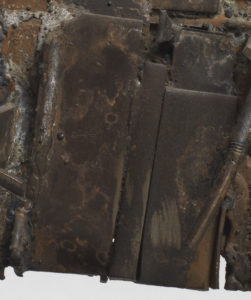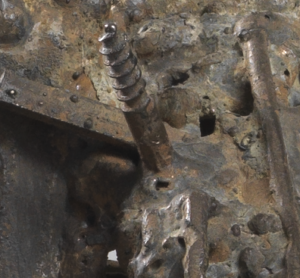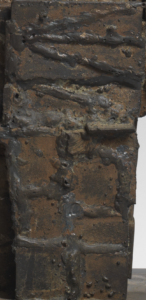
Though museums and galleries are closed at the moment, our most recent McQueens Illuminating Objects Intern, Jack Monaghan, has still been hard at work.
Later this year, one of our rarely seen artworks – Habitation, by the French artist César -will go on loan to The Science Museum as part of our McQueens Illuminating Objects series. In the meantime, it can now be explored through a new digital display.
Jack explains the story of this artwork and why it belongs in a science museum as much as in an art gallery.
Habitation means a dwelling place or home, so it is fitting that this piece is one that we are exploring during lockdown.
Habitation was created from over 100 separate pieces of scrap metal. These items were collected from a junkyard on the outskirts of Paris and welded together by César in 1960.
Habitation is a sculpture made almost entirely from steel. The sculpture is about 30cm high, 40cm wide, and 15cm deep. It has a mass of 12.5 kg. To translate this into a lockdown context – that’s about the size of a 24-pack of toilet roll, and the weight of thirty tins of chopped tomatoes.
Steel is by far the most widely used metal on Earth. It is used to make everything from the tins those chopped tomatoes came in, to the ship that carried the tins, the machinery that processed them, the structure of the warehouse that stored them, and (probably) the fork you will eat them with. That we use so much of it also means that an awful lot of steel is thrown away when it is no longer useful. As well as being the most widely used metal, steel is also the most widely recycled material on Earth.
It was discarded steel, found in a scrap yard, that César used to make his sculpture. So steel’s place in our homes is part of the story of Habitation’s place in The Science Museum.

Much of Habitation is made from thin, flat rectangles of sheet-steel. The sculpture contains at least 96 individual pieces, with different shapes, sizes, and thicknesses.
These pieces of steel are off-cuts from much larger sheets. The larger sheets were most likely used in the manufacture of industrial machinery and motor vehicles. These off-cuts were what was left over after a sheet had been cut to size. They were discarded in the scrap metal yard where, had they not been picked up by César, they would have eventually been sorted into different types and recycled into new steel sheets or other steel objects.
As well as sheet steel, Habitation contains at least 20 identifiable steel objects. Some are common items you might find in your home such as screws, bolts, and two spoon handles. Others are more unusual such as the shaft from a machine’s control valve, and a selection of metalworking tools.

These bits of discarded junk were collected by the artist from a scrap metal yard in Northern Paris. César took the metal pieces to his workshop (also in Northern Paris) and fused them together using a process called manual metal arc welding.
Arc welding uses a large electric current to bind two pieces of metal together. A welder does this using a thin stick of metal, called an electrode, which is connected to a generator. The welder moves this electrode close to the metal pieces they wish to weld and the electric current jumps across the gap as a tiny lightening bolt, known as an arc. The heat produced by the creation of this arc is enough to melt both the end of the electrode and the metal pieces at point the arc touches. This creates a pool of molten metal called a weld bead. When this weld bead cools and returns to its solid state it forms a very strong bond that fuses the two metal pieces together.

There are areas of César’s sculpture where the welding is neat and uniform – resembling sections of brick on a house exterior. There are other areas where the weld is messy, and the amount of melt is much greater than is necessary for a solid join. Here the texture is jumbled and bumpy, in stark contrast to the flatness of the sheet steel.
On other areas of the sculpture there are small hollow rings raised on the metal’s surface. These indicate frozen bubbles where gases, trapped in the molten metal, escaped as it cooled. Were this an industrial weld job these bubbles could be very dangerous as they would seriously undermine the strength of the joints. In the artwork they give the metal a living, breathing quality – not of a still and inert solid substance, but of something bubbling, seething, energetic and alive.
Habitation was created at a time of big change, both for the artist César and for steel production in France. To find out more about César, molten metal, and man-made lightening, visit the Habitation online display.
Habitation will be displayed in the Science Museum later this year.

